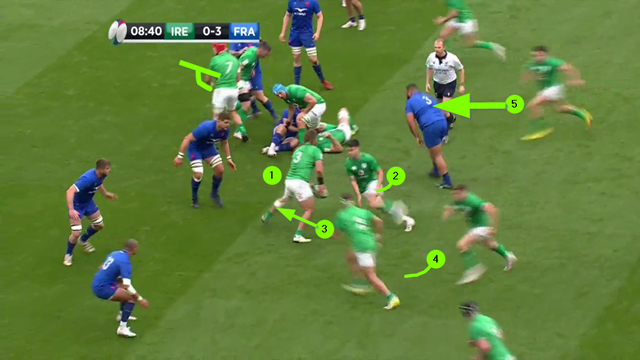The professional evolution of American Football in the United States has taken an interesting turn over the past decade. The game unquestionably has a more offensive accent with increased emphasis on player care, lowering tackle height to avoid those ‘helmet-to-helmet’ contacts which are most likely to result in concussions.
The quarterback position has also changed, with far more fluid passer/runners occupying the spot. The notion of the ‘pocket passer’, mostly immobile and staying within the ring of protection provided by his offensive linemen, is a relic of the past. He has been replaced by men who can pass but also run, and pass-on-the run proficiently. Superbowl winner Patrick Mahomes of the Kansas City Chiefs is a prime example: https://www.youtube.com/watch?v=QHEG7CRBUGA
The best quarterbacks are now players who can diagnose defences ‘on the run’, as the play begins to deconstruct. Sounds familiar? Similar trends can be detected in Rugby, where tackle height and head contact are also a major problem, and the quicker speed of breakdown ball has forced attacks to create options earlier in the phase count.
To recycle a boxing analogy, offensive teams which can put combinations together, and create several options quickly and consistently, tend to be more successful than those which are relying on a single set play, or ‘one big punch’.
This process can begin within the first couple of phases from either a set-piece, or kick return/counter starter. Let’s roll the clock back to the titanic clash between Ireland and France at the 2023 Six Nations, which was probably the best international match of the year.
Ireland’s first try of the game was based on a kick return where the men in green created an array of options on the second play. Then it became a matter of reading the defence and picking the right hole. The initial return phase into midfield set the scene for what was to come:
Switchback 1
The Ireland number 8 Caelan Doris is already signalling for the ball as soon as the catch is made by James Lowe and he receives a pass from full-back Hugo Keenan. Both know their roles in the attacking set-up, with Doris carrying deep into centre-field and Keenan shaving off behind the site of the intended ruck.
On second phase there are at least five different options available:
Switchback 2
The ball is played short to a ‘post’ [Ireland number 3 Finlay Bealham, “1”] standing right on the ad-line. He can
turn upfield and run himself,
transfer the ball back to “2” scrum-half Conor Murray on the wrap-around, with “4” Garry Ringrose in support outside him,
tip-on to “3” hooker Rob Herring,
pick a longer inside pass to “5” Keenan, coming from his masked position behind the ruck.
Number 4 is the right option because of the way the defence is oriented. Tight-head prop Uini Atonio is slow getting up off the ground and back into line, so he is not a part of the interior defence. Big Paul Willemse is looking out on to the threats beyond Bealham rather than in towards Keenan. The Ireland cleanout has levered open the gap further by sealing French defenders on the far side of the ruck away from the play.
The break is created by multiple men in motion overloading the decision-making process of key defenders, and forcing them to make an uncomfortable choice. You can often evaluate the success of a ‘multiple choice’ attacking question by how many of the threats it slingshots through the line in support of the initial bust, in the post-break scenario:
Switchback 3
In the angle from behind the posts, no less than four Ireland players have made it through the line unmarked in support of Keenan’s break. The play is an unqualified success because more than one of them could have dotted down the ball for the try.
Summary</b
The days of Super Rugby in the early noughties, where attacking sides could plot their upfield and bank on retaining the ball in double-digit ruck sequences, with the strike phase not occurring until 6th or 8th or 12th phase, are long gone. Nowadays the professional game is all about creating multiple threats early in the phase-count, and sustaining those threats for longer on attack than the defence can successfully manage them.
Those threats will include several different runners entering the play at contrasting angles, while the chief ball-user may not be the player the defence expects it to be. It can also include a kicking option as well as the run/pass possibilities. Like Patrick Mahomes, Rugby is running for its life, and running for the future of the game.












.jpg)

.jpg)







